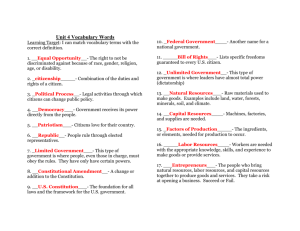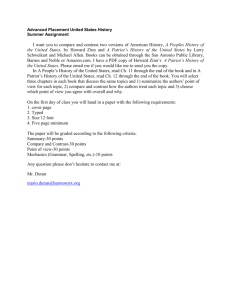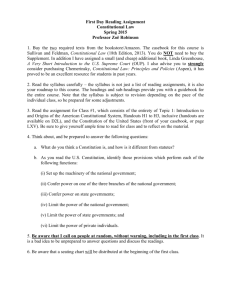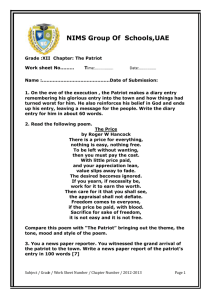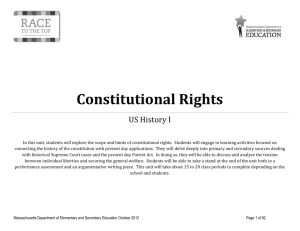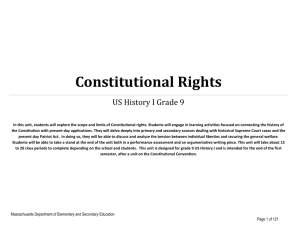UbD Template 2 - historymalden
advertisement
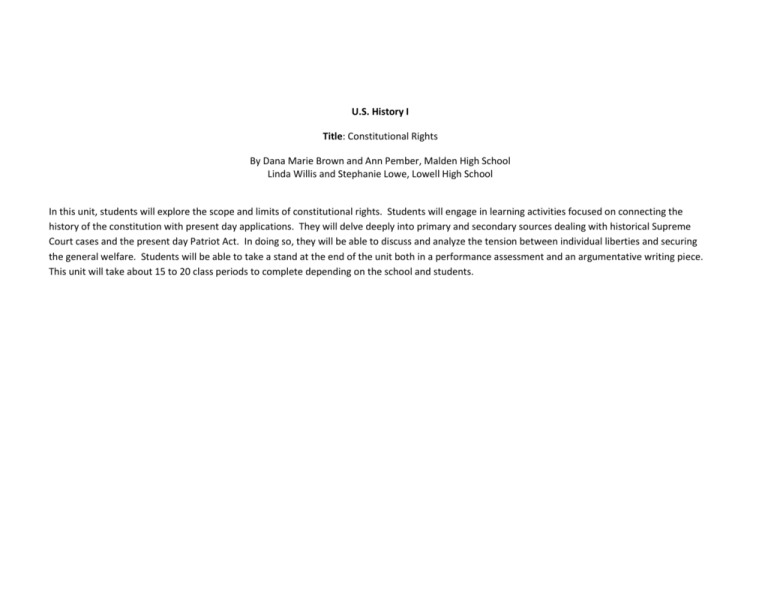
U.S. History I Title: Constitutional Rights By Dana Marie Brown and Ann Pember, Malden High School Linda Willis and Stephanie Lowe, Lowell High School In this unit, students will explore the scope and limits of constitutional rights. Students will engage in learning activities focused on connecting the history of the constitution with present day applications. They will delve deeply into primary and secondary sources dealing with historical Supreme Court cases and the present day Patriot Act. In doing so, they will be able to discuss and analyze the tension between individual liberties and securing the general welfare. Students will be able to take a stand at the end of the unit both in a performance assessment and an argumentative writing piece. This unit will take about 15 to 20 class periods to complete depending on the school and students. Name of Unit: Constitutional Rights Grade(s): 9/10 Stage 1 Desired Results G ○ Transfer Students will be able to independently use their learning to… ○T USI.14 Explain the characteristics of American 1. Analyze and resolve conflicts in order to work and live cooperatively with others democracy, including the concepts of popular 2. Apply knowledge of political and social systems to participate actively as informed sovereignty and constitutional government, which citizen of a democracy I includes representative institutions, federalism, Meaning separation of powers, shared powers, checks and UNDERSTANDINGS U ESSENTIAL QUESTIONS Q ○ ○ balances, and individual rights. Students will understand that… Q1 Is the Constitution a living document? (fix wording) 1. The Constitution establishes the rights and USI.19 Explain the rights and the responsibilities of responsibilities of the government and its citizens Q2 When should personal liberty be sacrificed for the citizenship and describe how a democracy provides common good? opportunities for citizens to participate in the political 2. The constitution provides a system for change process through elections, political parties, and through the amendments Q3 How far should the ideals of the constitution interest groups. extend? (fix wording) - tension 3. There is an ongoing debate over the limits of USI.21 Describe how decisions are made in a government power. democracy, including the role of legislatures, courts, Q4 What is the purpose of government? executives, and the public. 4. The language of the document was crucial Q5 Why do laws have to be interpreted? ELA 9-10. RH.4 Determine the meaning of words and because it allowed for interpretation (fix wording) phrases as they used in a text, including vocabulary describing political, social or economic aspects of 5. There is a process for judicial review history/social studies ESTABLISHED GOALS 6-8. RH.2 Determine the central ideas or information of a primary or secondary source; provide an accurate summary of the source distinct from prior knowledge or opinions. W9.1 (grade 9)– Write arguments to support claims in an analysis of substantive topics or texts, using valid reasoning and relevant and sufficient evidence. SL1 (grade 9)- Initiate and participate effectively in a Students will know… Important key terms including constitution Democracy Checks and balances Judicial review Constitutionality Amendment Bill of rights Congress Acquisition ○K Students will be skilled at… ○S determining cause and effect writing for a variety of purposes Using content specific vocabulary in writing Analyzing primary and secondary sources Identifying and analyzing opposing viewpoints Identifying sources as credible evidence Debate from multiple perspectives Identify main idea and details range of collaborative discussions (one-on-on, in groups, and teacher-led) with diverse partners on grades 9-10 topics, texts, and issues, building on others’ ideas and expressing their own clearly and persuasively. SL2 (grade 9) - Integrate multiple sources of information presented in diverse media or formats (e.g., visually, quantitatively, orally) evaluating the credibility and accuracy of each source. SL3 (grade 9) - Evaluate a speaker’s point of view, reasoning, and use of evidence and rhetoric, identifying any fallacious reasoning or exaggerated or distorted evidence. SL4 (grade 9) -Present information, findings, and supporting evidence clearly, concisely, and logically such that listeners can follow the line of reasoning and the organization, development, substance, and style are appropriate to purpose, audience, and task. Senate Supreme Court Separation of powers Process of judicial review Structure of the document Patriot Act Stage 2 – Evidence Evaluative Criteria Performance Task Assessment Evidence TRANSFER TASK(S): Performance Task CEPA – You are present at a Senate Committee TRANSFER TASK(S): meeting to discuss the renewal and constitutionality of Writing Prompts w/rubrics: the Patriot Act. You are given a role that you will Lesson #2: Why does the Supreme Court get to decide what is constitutional? Why can’t any citizen just read research and collect data on before the big meeting. the constitution on this/her own and interpret the laws? The purpose is to create a strong argument for your Lesson #4: Do you think it is worth sacrificing your civil liberties in order to prevent terrorism? How much side which you will present before the Committee. personal freedom are you will to give up? How has your definition of freedom changed in light of protecting the general welfare? Does the Patriot Act go too far in defending our security, at the cost of protecting our individual liberties? Roles: News reporters/Media (5-7), Celebrity Proponent (1), Celebrity Opponent (1), Homeland Security committee (4-5), Budget Committee (45), Judiciary Committee (4-5), Intelligence committee (4-5), Vice President Follow Up Writing Assignment: Reflect on your argument. Based on your participation in the Congressional Committee meeting, how would you vote if Congress put this question on the next General Election ballot? IS your answer the same as before the meeting? If so, explain why your opinion has not changed. If your opinion has changed, is there a committee that swayed your thoughts? What specifically did they say to do so? Accountable Talk w/rubrics: Lesson #3: Fishbowl Discussion based on questions and comments of text based discussion with notes Technology task w/rubric: Lesson #3: Using Web 2.0 tool create a slide, glog or animoto using criteria from lesson Stage 3 – Learning Plan Lesson Plans to include: Lesson #1 – Preview Unit on Constitutional Rights Lessons #2 – The Role of Judicial Review in the Supreme Court Lesson #3 – The Bill of Rights and Student Rights Lesson #4 – The Constitutionality of the Patriot Act Lessons #5 – Tools and Strategies for Argument Writing and Speaking Lesson #6 – Research and data Collection Tools Lesson #7 – CEPA and Follow Up Argument Writing Piece Learning Activities Lesson #1: Introduction Identify prior knowledge through the A to Z Anticipation Guide on the Purpose of United States Government Define the term Constitutional Rights using a Frayer Model Analyze a video clip using an I Hear/It Means on the Teachers Domain video clip: Minersville School District vs. Gobitis Accountable Talk Discussion Questions: Minersville School District vs. Gobitis Answer the following question: What is the purpose of government? Lesson #2: Respond to prompts and share what they would do if they were the mayor of Malden Mark up a reading of Marbury v. Madison and answer several review questions to check for understanding Interpret a political cartoon on the court case using the “I see/It means” method Graphic organizer to be completed during the “Hollywood Squares” game Quick write reflection at the end of the “Hollywood Squares” game Glogster Technology Skill: students will answer the prompt: why does the Supreme Court get to decide what is constitutional? Why can’t any citizen just read the constitution on their own and interpret the laws?” Written explanation why they think the founding fathers decided to include a federal judiciary court in our government as a closing activity Lesson #3: Summarize the Bill of Rights in their own words Apply the principles of the Bill of Rights to a Court case Mark up the text of a Court Case to make connections and apply theories of the Bill of Rights Identify connections from the Bill of Rights to today Analyze a primary source Accountable Talk using a Fishbowl Discussion with guided discussion questions on a court case Lesson #4: Determine if list of scenarios are either patriotic or unpatriotic with summary Identify where on a spectrum of liberty versus security situations fit Concept Event Map of the Patriot Act determining the main idea and key details Define key terms and illustrate of important ideas from the Patriot Act Explain 10 sections of the Patriot Act with positives and negatives for each section Written Opinion: do you think it is worth sacrificing your civil liberties in order to prevent terrorism? How much personal freedom are you willing to give up? How has your definition of freedom changed in light of protecting the general welfare? Does the Patriot Act go too far in defending our security, at the cost of protecting our individual liberties? Lesson #5: Identify key features of an argument Analyze how an author’s ideas or claims are developed Identify aspects of a text that reveal an author’s point of view or purpose Write arguments clearly using sufficient evidence to support a claim Present information, findings, and supporting evidence such that listeners can follow the line of reasoning Lesson #6: Define of bias, source, reliable, primary and secondary sources Critically think about Websites questions after viewing two different fake websites Mark up the text of Evaluating Web Pages Checklist to identify most important skills Identify and explain Primary and Secondary sources example review sheet Answer Reliable Resources questions about the main websites they use for research Collect research data Lesson #7: Graphic organizer determining each group’s talking points during the presentation Written self-reflection on presentation and committee meeting Persuasive writing on their opinion of the Patriot Act Resources Teacher Resources: http://constitutioncenter.org/ http://www.usconstitution.net/constteach.html http://www.socialstudies.org/teacherslibrary



